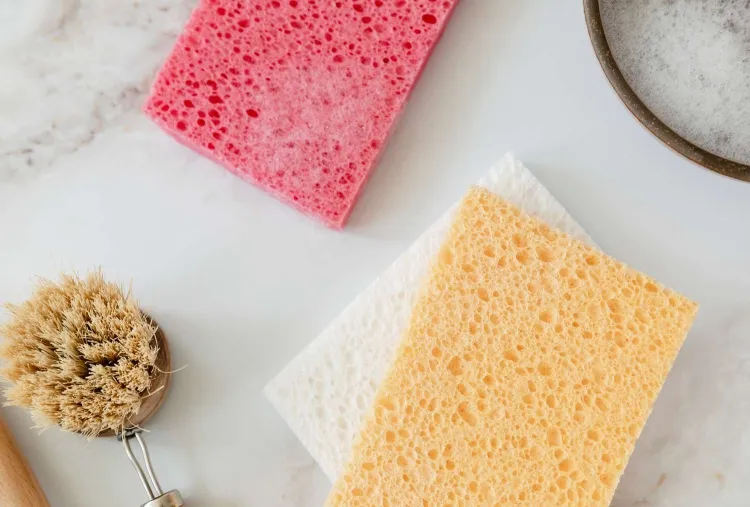Uses of Sponges and How They Are Made...!!!
Sponges are essential tools with a wide range of uses in household cleaning, personal care, automotive care, crafting, and medical applications.

Sponges are incredibly versatile materials that play a significant role in various aspects of daily life. From cleaning to crafting, sponges serve multiple purposes and come in different types, each suited for specific tasks.
Uses of Sponges
-
Household Cleaning:
-
Dishwashing: Sponges are widely used for washing dishes, pots, and pans. They are effective at scrubbing away food residues and grease.
-
Surface Cleaning: Sponges are ideal for cleaning countertops, sinks, and other surfaces. They can absorb spills and wipe away dirt and grime.
-
Bathroom Cleaning: Sponges are used to clean bathroom fixtures, such as sinks, bathtubs, and tiles. Their abrasive side helps remove soap scum and mildew.
-
-
Personal Care:
-
Bathing: Natural sponges are often used for bathing and exfoliating the skin. They provide a gentle scrubbing action and help remove dead skin cells.
-
Cosmetics: Makeup sponges are used to apply foundation, concealer, and other cosmetic products. They help achieve a smooth and even application.
-
-
Automotive Care:
-
Car Washing: Sponges are commonly used for washing cars. They help remove dirt and grime from the vehicle's surface without scratching the paint.
-
-
Crafting and Art:
-
Painting: Sponges are used in various painting techniques, such as sponge painting, to create texture and patterns on surfaces.
-
Craft Projects: Sponges can be cut into shapes and used in craft projects for stamping, painting, and other creative activities.
-
-
Medical and Laboratory Use:
-
Surgical Sponges: Sterile sponges are used in medical procedures to absorb blood and fluids and keep the surgical area clean.
-
Laboratory Use: Sponges are used in laboratories for cleaning and absorbing liquids.
-

Making of Sponges
The process of making sponges varies depending on the type of sponge being produced. There are natural sponges and synthetic sponges, each with its own manufacturing process.
-
Natural Sponges:
-
Harvesting: Natural sponges are harvested from the ocean, typically collected by divers from the seabed.
-
Processing: Once harvested, the sponges are cleaned to remove any debris, algae, and other impurities. They are then soaked in a mild bleach solution to whiten them.
-
Drying: After cleaning, the sponges are rinsed thoroughly and left to dry. This process helps preserve their natural structure and texture.
-
Cutting and Packaging: The dried sponges are cut into various sizes and shapes, depending on their intended use. They are then packaged and distributed for sale.
-
-
Synthetic Sponges:
-
Raw Materials: Synthetic sponges are made from various materials, including cellulose, polyurethane, and polyester. The choice of material depends on the desired properties of the sponge.
-
Cellulose Sponges: Made from wood pulp, these sponges are biodegradable and environmentally friendly.
-
Polyurethane Sponges: Made from foam, these sponges are durable and often used for heavy-duty cleaning tasks.
-
Polyester Sponges: These sponges are soft and absorbent, making them suitable for personal care and cosmetic use.
-
-
Manufacturing Process:
-
Mixing: The raw materials are mixed with additives, such as softeners, colorants, and foaming agents, to create a homogeneous mixture.
-
Foaming: The mixture is poured into molds and heated to activate the foaming agents. This causes the mixture to expand and form a sponge-like structure.
-
Curing: The foamed mixture is allowed to cure and solidify, helping stabilize the sponge's structure.
-
Cutting and Shaping: The cured sponges are cut into the desired sizes and shapes using automated cutting machines.
-
Finishing: The sponges undergo additional processing, such as adding an abrasive layer or coating, to enhance their cleaning performance.
-
Packaging: The finished sponges are inspected for quality, packaged, and prepared for distribution.
-
-
Sponges are essential tools with a wide range of uses in household cleaning, personal care, automotive care, crafting, and medical applications. The process of making sponges varies depending on whether they are natural or synthetic, with each type offering unique benefits. Understanding the different uses and manufacturing processes of sponges can help individuals choose the right sponge for their specific needs.
What's Your Reaction?

















